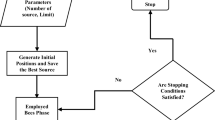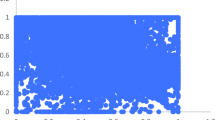Abstract
Picture fuzzy time series has been defined recently and a high order single variable forecasting method was proposed in the literature. Picture fuzzy time series definition is based on picture fuzzy sets which are the extended version of the fuzzy sets. So, more information is added for the modelling procedure with the use of picture fuzzy sets instead of classical fuzzy sets. In this study, high order multivariate picture fuzzy time series forecasting model is firstly defined and a forecasting algorithm based on this model is introduced. The proposed method uses picture fuzzy clustering and Pi-Sigma artificial neural networks as creating picture fuzzy time series and estimating of picture fuzzy forecasting model, respectively. The Pi-Sigma artificial neural network is trained by particle swarm optimization. The proposed method is applied to the TAIEX stock exchange data sets using Dow Jones and NASDAQ stock exchange data sets and Turkish lira exchange rates data sets using the dollar, euro and pound data sets as factor variables. The proposed method produces the best results among established benchmarks.





Similar content being viewed by others
References
Abhishekh, K. S. (2019). A modified weighted fuzzy time series model for forecasting based on two-factors logical relationship. International Journal of Fuzzy Systems, 21(5), 1403–1417.
Abhishekh, G. S. S., & Singh, S. R. (2018). A refined method of forecasting based on high-order intuitionistic fuzzy time series data. Progress in Artificial Intelligence, 7, 339–350.
Ahmadi, M. (2020). A computational approach to uncovering economic growth factors. Computational Economics. https://doi.org/10.1007/s10614-020-09985-1
Ahmadi, M., Jafarzadeh-Ghoushchi, S., Taghizadeh, R., & Sharifi, A. (2019). Presentation of a new hybrid approach for forecasting economic growth using artificial intelligence approaches. Neural Computing and Applications, 31(12), 8661–8680.
Bisht, K., & Kumar, S. (2019). Intuitionistic fuzzy set-based, computational method for financial time series forecasting. Fuzzy Information and Engineering, 10(3), 307–323.
Bose, M., & Mali, K. (2019). Designing fuzzy time series forecasting models: A survey. International Journal of Approximate Reasoning, 111, 78–99.
Cagcag Yolcu, O., & Lam, H. K. (2017). A combined robust fuzzy time series method for prediction of time series. Neurocomputing, 247, 87–101.
Cai, Q., Zhang, D., Zheng, W., & Leung, S. C. (2015). A new fuzzy time series forecasting model combined with ant colony optimization and auto-regression. Knowledge-Based Systems, 74, 61–68.
Chen, S. M. (1996). Forecasting enrollments based on fuzzy time-series. Fuzzy Sets and Systems, 81, 311–319.
Chen, S. M., & Chang, Y. C. (2010). Multi-variable fuzzy forecasting based on fuzzy clustering and fuzzy rule interpolation techniques. Information Sciences, 180(24), 4772–4783.
Chen, S. M., & Chen, C. D. (2011). TAIEX forecasting based on fuzzy time series and fuzzy variation groups. IEEE Transactions on Fuzzy Systems, 19(1), 1–12.
Chen, S. M., & Chen, S. W. (2015). Fuzzy forecasting based on two factors second-order fuzzy-trend logical relationship groups and the probabilities of trends of fuzzy logical relationships. IEEE Transactions on Cybernetics, 45(3), 391–403.
Chen, S. M., & Kao, P. Y. (2013). TAIEX forecasting based on fuzzy time series, particle swarm optimization techniques and support vector machines. Information Sciences, 247, 62–71.
Chen, S. M., Manalu, G. M. T., Pan, J. S., & Liu, H. C. (2013). Fuzzy forecasting based on two-factors second-order fuzzy-trend logical relationship groups and particle swarm optimization techniques. IEEE Trans Cybern, 43(3), 1102–1117.
Chen, S. M., Zou, X. Y., & Gunawan, G. C. (2019). Fuzzy time series forecasting based on proportions of intervals and particle swarm optimization techniques. Information Sciences, 500, 127–139.
Cheng, C. H., & Chen, C. H. (2018). Fuzzy time series model based on weighted association rule for financial market forecasting. Expert Systems, 35(4), e12271.
Cheng, S. H., Chen, S. M., & Jian, W. S. (2016). Fuzzy time series forecasting based on fuzzy logical relationships and similarity measures. Information Sciences, 327, 272–287.
Dong, L., Wang, P., & Yan, F. (2019). Damage forecasting based on multi-factor fuzzy time series and cloud model. Journal of Intelligent Manufacturing, 30, 521–538.
Egrioglu, E., Bas, E., Aladag, C. H., & Yolcu, U. (2016). Probabilistic fuzzy time series method based on artificial neural network. American Journal of Intelligent Systems, 6(2), 42–47.
Egrioglu, E., Bas, E., Yolcu, U., & Chen, M. Y. (2020). Picture fuzzy time series: Defining, modeling and creating a new forecasting method. Engineering Applications of Artificial Intelligence, 88, 103367.
Fan, X., Wang, Y., & Zhang, M. (2020). Network traffic forecasting model based on long-term intuitionistic fuzzy time series. Information Sciences, 506, 131–147.
Guan, H., He, J., Guan, S., & Zhao, A. (2019). Neutrosophic soft sets forecasting model for multi-attribute time series. IEEE Access, 7, 25575–25588.
Guan, H., He, J., Zhao, A., Dai, Z., & Guan, S. (2018). A forecasting model based on multi-valued neutrosophic sets and two-factor, third-order fuzzy fluctuation logical relationships. Symmetry, 10(7), 245.
Guo, H., Pedryc, W., & Liu, X. (2019). Fuzzy time series forecasting based on axiomatic fuzzy set theory. Neural Computing and Applications, 31, 3921–3932.
Huarng, K. H., Yu, T. H. K., & Hsu, Y. W. (2007). A multivariate heuristic model for fuzzy time-series forecasting. IEEE Transactions on Systems, Man, and Cybernetics, Part b: Cybernetics, 37(4), 836–846.
Ilieva, G. (2019). Fuzzy supervised multi-period time series forecasting. Cybernetics and Information Technologies, 19(2), 74–86.
Jilani, T., Housley, G., Figueredo, G., Tang, P. S., Hatton, J., & Shaw, D. (2019). Short and long term predictions of hospital emergency department attendances. International Journal of Medical Informatics, 129, 167–174.
Kennedy, J., & Eberhart, R. (1995). Particle swarm optimization, In Proceedings of IEEE International Conference on Neural Networks, Piscataway, IEEE Press., 1942–1948
Khan, M. Z., & Khan, M. F. (2019). Application of ANFIS, ANN and fuzzy time series models to CO2 emission from the energy sector and global temperature increase. International Journal of Climate Change Strategies and Management, 11(5), 622–642.
Li, F., & Yu, F. (2020). Multi-factor one-order cross-association fuzzy logical relationships based forecasting models of time series. Information Sciences, 508, 309–328.
Liu, Z., & Zhang, T. (2019). A second-order fuzzy time series model for stock price analysis. Journal of Applied Statistics, 46(14), 2514–2526.
Panigrahi, S., & Behera, H. S. (2020). A study on leading machine learning techniques for high order fuzzy time series forecasting. Engineering Applications of Artificial Intelligence, 87, 103245.
Sadaei, H. J., Silva, P. C. L., Guimaraes, F. G., & Lee, M. H. (2019). Short-term load forecasting by using a combined method of convolutional neural networks and fuzzy time series. Energy, 175, 365–377.
Shin, Y. and Gosh, J. (1991) The Pi-sigma network: An efficient higher-order neural network for pattern classification and function approximation. In Proceedings of the International Joint Conference on Neural Networks.
Silva, P. C. L., Sadaei, J. H., Ballini, R., & Guimaraes, F. G. (2020). Probabilistic forecasting with fuzzy time series. IEEE Transactions on Fuzzy Systems. https://doi.org/10.1109/TFUZZ.2019.2922152
Singh, P., & Dhiman, G. (2018). A hybrid fuzzy time series forecasting model based on granular computing and bio-inspired optimization approaches. Journal of Computational Science, 27, 370–385.
Song, Q., & Chissom, B. S. (1993). Fuzzy time series and its models. Fuzzy Sets and Systems, 54, 269–277.
Taghizadech, R., & Ahmadi, M. (2019). Statistical and econometrical analysis of knowledge-based economy indicators affecting economic growth in Iran: The new evidence of principal component analysis—Tukey and ARDL bound test. Journal of Policy Modeling, Preprint: January, 10.
Thong, P. H., & Son, L. H. (2016). Picture fuzzy clustering: A new computational intelligence method. Soft Computing, 20, 3549–3562.
Vovan, T. (2019). An improved fuzzy time series forecasting model using variations of data. Fuzzy Optimization and Decision Making, 18, 151–173.
Wei, D., Wang, J., Ni, K., & Tang, G. (2019). Research and application of a novel hybrid model based on a deep neural network combined with fuzzy time series for energy forecasting. Energy, Energies, 12(18), 3588.
Xian, S., Zhang, J., Xiao, Y., & Pang, J. (2018). A novel fuzzy time series forecasting method based on the improved artificial fish swarm optimization algorithm. Soft Computing, 22, 3907–3917.
Ye, F., Zhang, L., Zhang, D., Fujita, H., & Gong, Z. (2016). A novel forecasting method based on multi-order fuzzy time series and technical analysis. Information Sciences, 367–368, 41–57.
Yolcu, U., Bas, E., & Egrioglu, E. (2018). A new fuzzy inference system for time series forecasting and obtaining the probabilistic forecasts via subsampling block bootstrap. Journal of Intelligent and Fuzzy System, 35(2), 2349–2358.
Yu, T. H. K., & Huarng, K. H. (2010). A neural network-based fuzzy time series model to improve forecasting. Expert Systems with Applications, 37(4), 3366–3372.
Zhang, W., Zhang, S., Zhang, S., Yu, D., & Huang, N. (2019). A novel method based on FTS with both GA-FCM and multifactor BPNN for stock forecasting. Soft Computing, 23(16), 6979–6994.
Zhao, L., & Yang, Y. (2009). PSO-based single multiplicative neuron model for time series prediction. Expert Systems with Applications, 36, 2805–2812.
Author information
Authors and Affiliations
Corresponding author
Ethics declarations
Conflict of interest
We have no known conflict of interest to disclose.
Additional information
Publisher's Note
Springer Nature remains neutral with regard to jurisdictional claims in published maps and institutional affiliations.
Rights and permissions
About this article
Cite this article
Bas, E., Egrioglu, E. & Tunc, T. Multivariate Picture Fuzzy Time Series: New Definitions and a New Forecasting Method Based on Pi-Sigma Artificial Neural Network. Comput Econ 61, 139–164 (2023). https://doi.org/10.1007/s10614-021-10202-w
Accepted:
Published:
Issue Date:
DOI: https://doi.org/10.1007/s10614-021-10202-w




